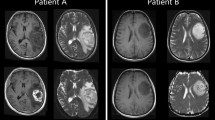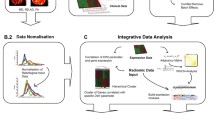Abstract
Low-grade gliomas can vary widely in disease course and therefore patient outcome. While current characterization relies on both histological and molecular analysis of tissue resected during surgery, there remains high variability within glioma subtypes in terms of response to treatment and outcome. In this study we hypothesized that parameters obtained from magnetic resonance data would be associated with progression-free survival for patients with recurrent low-grade glioma. The values considered were derived from the analysis of anatomic imaging, diffusion weighted imaging, and 1H magnetic resonance spectroscopic imaging data. Metrics obtained from diffusion and spectroscopic imaging presented strong prognostic capability within the entire population as well as when restricted to astrocytomas, but demonstrated more limited efficacy in the oligodendrogliomas. The results indicate that multi-parametric imaging data may be applied as a non-invasive means of assessing prognosis and may contribute to developing personalized treatment plans for patients with recurrent low-grade glioma.




Similar content being viewed by others


References
Shaw EG, Wisoff JH (2003) Prospective clinical trials of intracranial low-grade glioma in adults and children. Neuro-Oncology 5(3):153–160. doi:10.1215/S1152-8517-02-00060-1
Jaeckle KA, Decker PA, Ballman KV, Flynn PJ et al (2011) Transformation of low grade glioma and correlation with outcome: an NCCTG database analysis. J Neurooncol 104(1):253–259
Grier JT, Batchelor T (2006) Low-grade gliomas in adults. The Oncologist 11(6):681–693
Wang H-Y, Tang K, Liang T-Y, Zhang W-Z et al (2016) The comparison of clinical and biological characteristics between IDH1 and IDH2 mutations in gliomas. J Exp Clin Cancer Res 35:86. doi:10.1186/s13046-016-0362-7
Leeper HE, Caron AA, Decker PA, Jenkins RB, Lachance DH, Giannini C (2015) IDH mutation, 1p19q codeletion and ATRX loss in WHO grade II gliomas. Oncotarget 6(30):30295–30305
Louis DN, Perry A, Reifenberger G, von Deimling A, Figarella-Branger D, Cavenee WK, Ohgaki H, Wiestler OD, Kleihues P, Ellison DW (2016) The 2016 World Health Organization classification of tumors of the central nervous system: a summary. Acta Neuropathol. 131:803–820.
Basser PJ, Pierpaoli C (1996) Microstructural and physiological features of tissues elucidated by quantitative-diffusion-tensor MRI. J Magn Reson 111(3):209–219
Wen Q, Jalilian L, Lupo JM et al (2015) Comparison of ADC metrics and their association with outcome for patients with newly diagnosed glioblastoma being treated with radiation therapy, temozolomide, erlotinib and bevacizumab. J Neurooncol 121:331–339
Hilario A, Sepulveda JM, Perez-Nuñez A et al (2014) A prognostic model based on preoperative MRI predicts overall survival in patients with diffuse gliomas. Am J Neuroradiol 35:1096–1102
Romano A, Calabria LF, Tavanti F, Minniti G, Rossi-Espagnet MC, Coppola V, Pugliese S, Guida D, Francione G et al (2013) Apparent diffusion coefficient obtained by magnetic resonance imaging as a prognostic marker in glioblastomas: correlation with MGMT promoter methylation status. Eur Radiol 23:513–520
Zulfiqar M, Yousem D, Lai H (2013) ADC Values and Prognosis of Malignant Astrocytomas: Does Lower ADC Predict Worse Prognosis Independent of Grade of Tumor? – A Meta-Analysis. Am J Roentgenol 200:624–629
Cuccarini V, Erbetta A, Farinotti M et al (2016) Advanced MRI may complement histological diagnosis of lower grade gliomas and help in predicting survival. J Neurooncol 126(2):279–288
Caseiras GB, Chheang S, Babb J et al (2010) Relative cerebral blood volume measurements of low-grade gliomas predict patient outcome in a multi-institution setting. Eur J Radiol 73(2):215–220
Khayal IS, VandenBerg SR, Smith KJ, et al. (2011). MRI apparent diffusion coefficient reflects histopathologic subtype, axonal disruption, and tumor fraction in diffuse-type grade II gliomas. Neuro-Oncology. 13(11):1192–1201. doi:10.1093/neuonc/nor122.
Gupta RK, Cloughesy TF, Sinha U, Garakian J, Lazareff J, Rubino G, Rubino L, Becker DP, Vinters HV, Alger JR (2000) Relationships between choline magnetic resonance spectroscopy, apparent diffusion coefficient and quantitative histopathology in human glioma. J Neurooncol 50:215–226
Brunberg JA, Chenevert TL, McKeever PE et al (1995) In vivo MR determination of water diffusion coefficients and diffusion anisotropy: correlation with structural alteration in gliomas of the cerebral hemispheres. Am J Neuroradiol 16:361–371
Jalbert L, Neill E, Phillips J, Lupo J, et al. (2016). Magnetic resonance analysis of malignant transformation in recurrent glioma. Neuro Oncology. 18:1169–1179.
Qu J, Qin L, Cheng S et al (2016) Residual low ADC and high FA at the resection margin correlate with poor chemoradiation response and overall survival in high-grade glioma patients. Eur J Radiol 85(3):657–664
Li Y, Chen AP, Crane JC, Chang SM, Vigneron DB, Nelson SJ (2007) Three-dimensional J-resolved H-1 magnetic resonance spectroscopic imaging of volunteers and patients with brain tumors at 3 T. Magn Reson Med 58(5):886–892
Oh J, Henry RG, Pirzkall A, Lu Y, Li X, Catalaa I, Chang S, Dillon WP, Nelson SJ (2004) Survival Analysis in patients with glioblastoma multiforme: predictive value of choline-to-N-acetylaspartate index, apparent diffusion coefficient, and relative cerebral blood volume. J Magn Reson Imaging 19(5):546–554
Saraswathy S, Crawford FW, Lamborn KR, Pirzkall A, Chang S, Cha S, Nelson SJ (2009) Evaluation of MR markers that predict survival in patients with newly diagnosed GBM prior to adjuvant therapy. J Neurooncol 91(1):69–81
Li X, Jin H, Lu Y, Oh J, Chang S, Nelson SJ (2004) Identification of MRi and 1 H MRSI parameters that may predict survival for patients with malignant gliomas. NMR Biomed 17(1):10–20
Hattingen E, Raab P, Franz K, Lanfermann H, Setzer M, Gerlach R, Zanella E, Pilatus U (2008) Prognostic value of choline and creatine in WHO grade II gliomas. Neuroradiology 50(9):759–767
Park I, Chen AP, Zierhut ML, Ozturk-Isik E, Vigneron DB, Nelson SJ (2011) Implementation of 3 T lactate-edited 3D 1 H MR spectroscopic imaging with flyback echo-planar readout for gliomas patients. Ann Biomed Eng 39:193–204
McKnight TR, Noworolski SM, Vigneron DB, Nelson SJ (2001) An automated technique for the quantitative assessment of 3D-MRSI data from patients with glioma. J Magn Reson Imaging 13(2):167–177
Wen P, Macdonald D, Reardon D, Cloughesy T et al (2010) Updated response assessment criteria for high-grade gliomas: response assessment in neuro-oncology working group. J Clin Onc 28(11):1973–1972
Khayal IS, McKnight TR, McGue C, Vandenberg S, Lamborn KR, Chang SM, Cha S, Nelson SJ (2009) Apparent diffusion coefficient and fractional anisotropy of newly diagnosed grade II gliomas. NMR Biomed 22:449–455
Bian W, Khayal IS, Lupo JM, McGue C, Vandenberg S, Lamborn KR, Chang SM, Cha S, Nelson SJ (2009) Multiparametric characterization of grade 2 glioma subtypes using magnetic resonance spectroscopic, perfusion, and diffusion imaging. Transl. Oncol 2:271–280
An Z, Ganji SK, Tiwari V, Pinho MC, Patel T, Barnett S, Pan E, Mickey BE, Maher EA, Choi C (2016) Detection of 2-hydroxyglutarate in brain tumors by triple-refocusing MR spectroscopy at 3 T in vivo. Magn Reson Med. doi:10.1002/mrm.26347
Li Y, Park I, Nelson SJ (2015) Imaging tumor metabolism using in vivo magnetic resonance spectroscopy. Cancer J 21:123–128
Acknowledgements
We thank the staff of the UCSF Margaret Hart Surbeck Laboratory and the UCSF Brain Tumor SPORE Tissue Bank. This research was funded by the UCSF Brain Tumor SPORE (P50 CA097257).
Author information
Authors and Affiliations
Corresponding author
Ethics declarations
Ethical approval
All procedures performed in studies involving human participants were in accordance with the ethical standards of the institutional and/or national research committee and with the 1964 Helsinki declaration and its later amendments or comparable ethical standards.
Rights and permissions
About this article
Cite this article
Neill, E., Luks, T., Dayal, M. et al. Quantitative multi-modal MR imaging as a non-invasive prognostic tool for patients with recurrent low-grade glioma. J Neurooncol 132, 171–179 (2017). https://doi.org/10.1007/s11060-016-2355-y
Received:
Accepted:
Published:
Issue Date:
DOI: https://doi.org/10.1007/s11060-016-2355-y


